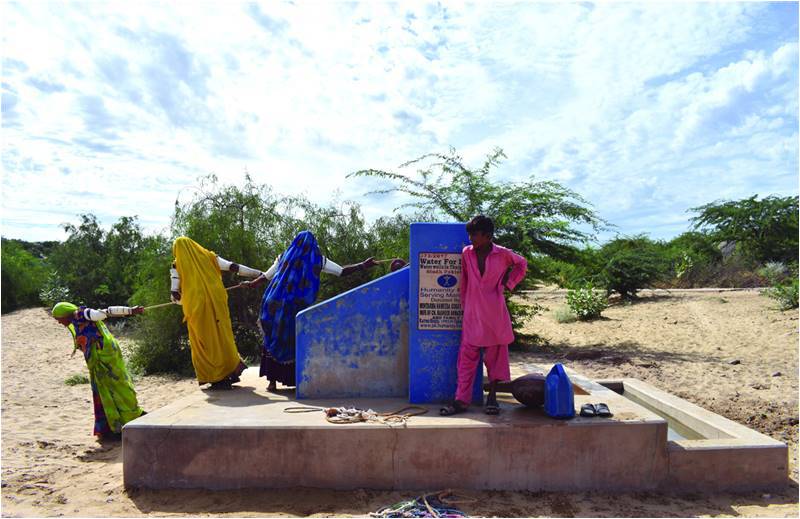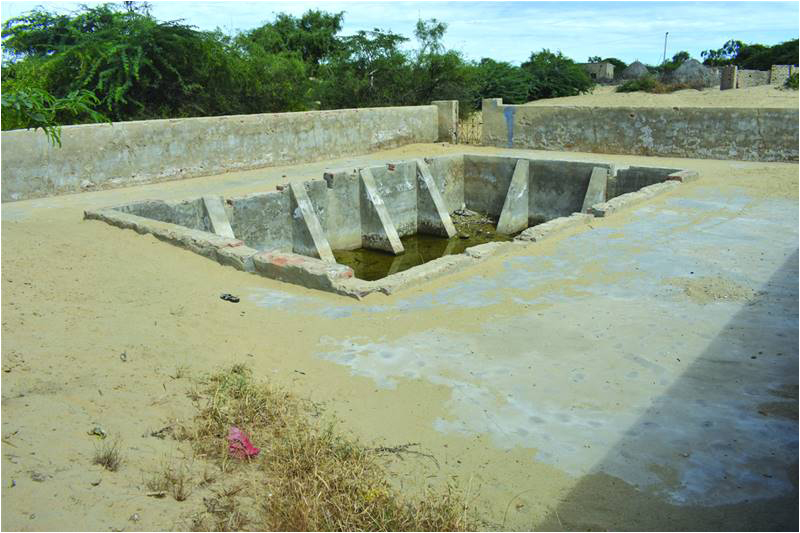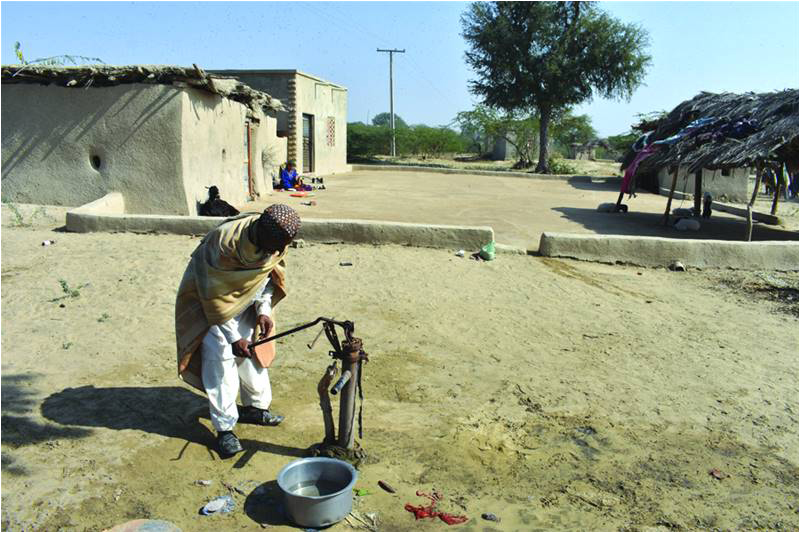
According to the Census of 2017, district Tharparkar’s total population is 1,649,661 – of which 1,517,590 humans live in rural areas and 90 percent of this population is still deprived of safe drinking water. Old wells and stored rainwater in small tanks/dams (taraiyun in Sindhi) are the primary means to quench the thirst of Tharis for centuries. Among 2,600 villages of Thar, very few have Reverse Osmosis plants and shockingly most of them have been nonfunctional for years. At different times, different governments announced different schemes and facilities for the people of Thar but these could not be implemented.
In 2017, Sindh government proposed a $33 million project to install 750 RO plants in Tharparkar but to date hardly 400 RO plants could be installed – and 70 percent of those installed RO plants have become nonfunctional. According to local journalists, if the government is thinking to install the rest of the plants in the future, it cannot do that because most of the machinery present in different villages either has expired or gone missing. Before this in 2015, the then Sindh government inaugurated the country’s largest reverse osmosis plant, the Hybrid Solar Desalination Plant in Mithi City, with the vision to supply 200 million gallons of filtered water to 100 villages of Talukas Mithi and Islamkot. But that water facility, too, couldn’t quench the thirst of Tharis.

As far as the work of private sector in Thar is concerned, they too have failed to provide essential supplies to Tharis. The work on water carried out by different NGOs in Thar since the early 1990s is much more than the work carried out elsewhere in the country, but the results are not impressive. In many villages the installed hand pumps From NGOs have become completely out-of-use or are close to that.
Coal corporations excavating that fuel from the land of Thar have also failed to fulfill their social responsibility to the local community.
When the winter season ends, the need for water increases in Thar drastically, so in that time Tharis have to rely on either stored rainwater or wellwater. But as the summer starts, they run short of water from either means. The natural dams don’t have the capacity to store rain water for a longer period and the level of groundwater in wells also goes further lower. People they have to travel miles to fetch water – or wait for something miraculous to happen, i.e. unexpected rains.

For Tharparkar it is famous that every alternate year there occurs a drought or famine. So 2018 was a drought year which was followed by the rains of last year. The latter brought little joy to Tharis, because the crops they cultivated on rainwater were eaten up and destroyed by the deadly locusts and the rainwater they stored has run out. 2020 may bring about a severe drought in Tharparkar.
In India, canal water is being provided to the people living in Rajhistan’s desert area through the 649-km-long Indira Gandhi Canal which starts from Indian Punjab and tails there at very last part of the desert.
Dr. Bakhshal Khan Lashari, Project Director at United States Pakistan Centre for Advanced Studies in Water ( UPCAS-W) at the Mehran University of Engineering and Technology, Jamshoro, says: “Though there is a difference between the topography of Indian Rajhistan and Pakistan’s Thar Desert, a canal can be built to provide water in Thar.”
The Sindh government cites what it describes as the federal government’s unfairness in water distribution among provinces. This, it says, is the main hurdle in providing canal water to Thar. In the past, when the Rainee Canal Project was the initiated in 2002 by WAPDA to irrigate lands situated in districts Sukkur, Ghotki and Khairpur through the Guddu Barrage, a feeding regulator for providing water to Thar was also constructed, from which the future Thar Canal was to be drawn. But unfortunately only first phase of that project could be completed till 2014 and no further work on that project could be carried out.
The writer is a freelance contributor and he can be reached at abbaskhaskheli110@gmail.com)
In 2017, Sindh government proposed a $33 million project to install 750 RO plants in Tharparkar but to date hardly 400 RO plants could be installed – and 70 percent of those installed RO plants have become nonfunctional. According to local journalists, if the government is thinking to install the rest of the plants in the future, it cannot do that because most of the machinery present in different villages either has expired or gone missing. Before this in 2015, the then Sindh government inaugurated the country’s largest reverse osmosis plant, the Hybrid Solar Desalination Plant in Mithi City, with the vision to supply 200 million gallons of filtered water to 100 villages of Talukas Mithi and Islamkot. But that water facility, too, couldn’t quench the thirst of Tharis.

As far as the work of private sector in Thar is concerned, they too have failed to provide essential supplies to Tharis. The work on water carried out by different NGOs in Thar since the early 1990s is much more than the work carried out elsewhere in the country, but the results are not impressive. In many villages the installed hand pumps From NGOs have become completely out-of-use or are close to that.
Coal corporations excavating that fuel from the land of Thar have also failed to fulfill their social responsibility to the local community.
When the winter season ends, the need for water increases in Thar drastically, so in that time Tharis have to rely on either stored rainwater or wellwater. But as the summer starts, they run short of water from either means. The natural dams don’t have the capacity to store rain water for a longer period and the level of groundwater in wells also goes further lower. People they have to travel miles to fetch water – or wait for something miraculous to happen, i.e. unexpected rains.

For Tharparkar it is famous that every alternate year there occurs a drought or famine. So 2018 was a drought year which was followed by the rains of last year. The latter brought little joy to Tharis, because the crops they cultivated on rainwater were eaten up and destroyed by the deadly locusts and the rainwater they stored has run out. 2020 may bring about a severe drought in Tharparkar.
In India, canal water is being provided to the people living in Rajhistan’s desert area through the 649-km-long Indira Gandhi Canal which starts from Indian Punjab and tails there at very last part of the desert.
Dr. Bakhshal Khan Lashari, Project Director at United States Pakistan Centre for Advanced Studies in Water ( UPCAS-W) at the Mehran University of Engineering and Technology, Jamshoro, says: “Though there is a difference between the topography of Indian Rajhistan and Pakistan’s Thar Desert, a canal can be built to provide water in Thar.”
The Sindh government cites what it describes as the federal government’s unfairness in water distribution among provinces. This, it says, is the main hurdle in providing canal water to Thar. In the past, when the Rainee Canal Project was the initiated in 2002 by WAPDA to irrigate lands situated in districts Sukkur, Ghotki and Khairpur through the Guddu Barrage, a feeding regulator for providing water to Thar was also constructed, from which the future Thar Canal was to be drawn. But unfortunately only first phase of that project could be completed till 2014 and no further work on that project could be carried out.
The writer is a freelance contributor and he can be reached at abbaskhaskheli110@gmail.com)

